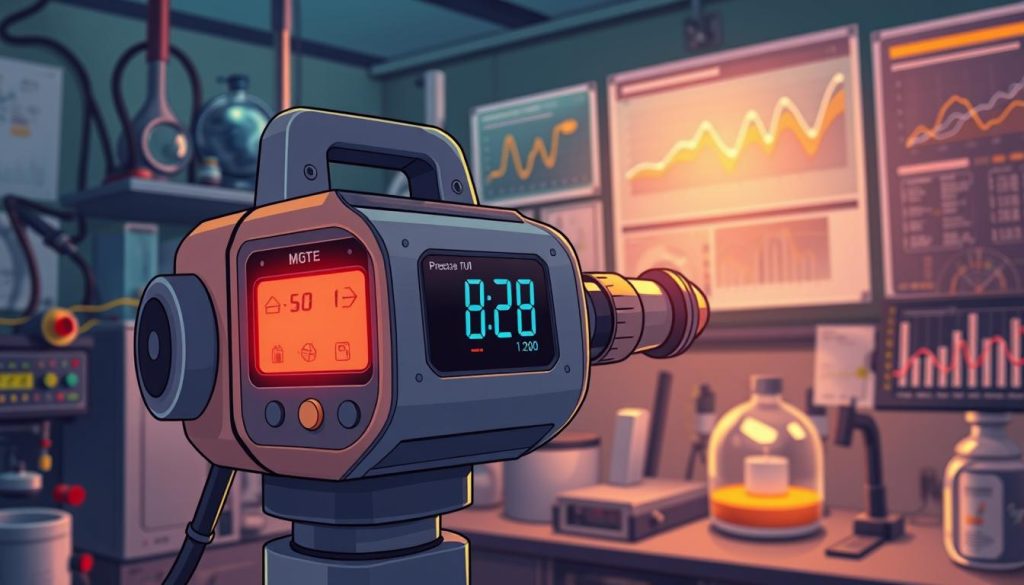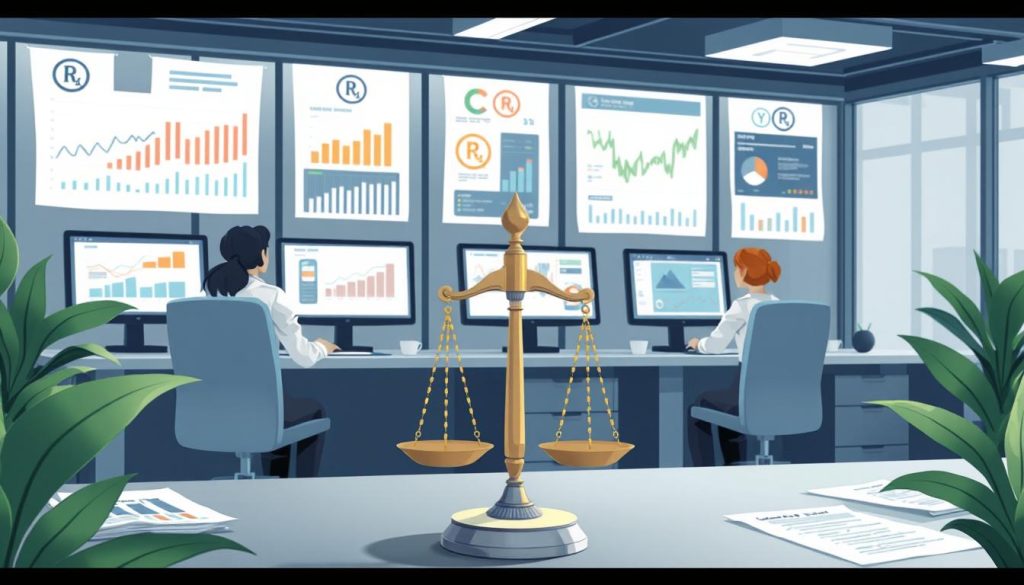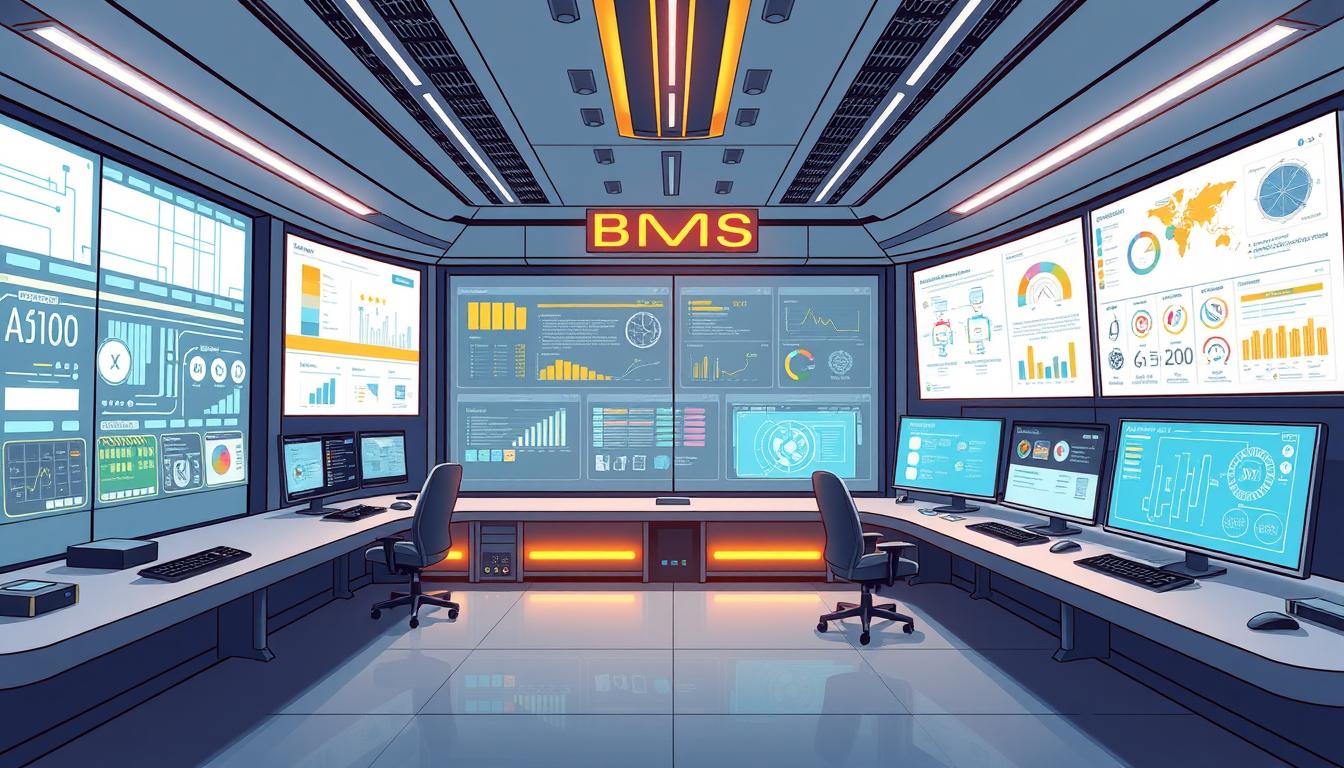If you manage buildings or facilities, you might have heard of “Building Management System” (BMS) and “Facility Monitoring System” (FMS). But do you really understand what they are? Knowing the difference is key to making sure your place runs smoothly and meets all the rules.
A BMS is a computer system that controls many parts of a building. It handles things like lights, heating, and security. On the other hand, an FMS is all about watching over special areas. This includes places where making things or doing research happens. It checks things like air quality and temperature to make sure everything is up to standard.
Key Takeaways
- BMS manages and controls various building systems, while FMS is dedicated to monitoring critical environmental parameters.
- BMS sensors are typically less accurate and have lower resolution than those used in an FMS, making them unsuitable for GMP data validation.
- FMS data is securely logged and stored independently, ensuring the integrity of critical GMP data, while BMS requires only commissioning for control limits and functionality.
- Integrating BMS and FMS can provide a comprehensive solution for building management and environmental monitoring.
- Regulatory considerations, such as compliance with industry standards, must be taken into account when implementing BMS and FMS.
Understanding BMS (Building Management System)
A building management system (BMS) is a computer system that controls a building’s facilities. It automates and optimizes various systems like mechanical and electrical equipment, power supplies, lighting, HVAC, ventilation, fire and smoke detection, and building access and security systems.
BMS are key in modern buildings for efficient management. They help save energy, improve comfort, and boost building performance. By monitoring all important parts, a BMS ensures everything runs smoothly.
Key Functions of a BMS
- Centralized control and monitoring of building systems
- Automated management of HVAC, lighting, and security systems
- Real-time data collection and analysis
- Energy optimization and cost savings
- Improved indoor air quality and occupant comfort
- Enhanced fire and safety monitoring
Using a building automation system, managers can make smart choices. They can quickly adapt to changes and improve the building’s efficiency and sustainability.
Benefits of Implementing a BMS
- Energy savings: BMS can cut down energy use by optimizing systems.
- Improved occupant comfort: It controls temperature, humidity, and lighting for better comfort.
- Increased operational efficiency: BMS makes maintenance and troubleshooting easier, saving time and resources.
- Enhanced safety and security: It integrates fire and security systems for better safety.
- Comprehensive data monitoring: BMS offers detailed, real-time data for better decision-making.
By using a building management system, managers gain more control and efficiency. This leads to a better experience for occupants and a more sustainable, cost-effective operation.
The Role of FMS (Facility Monitoring System)
A Facility Monitoring System (FMS) is different from a Building Management System (BMS). While a BMS handles many building systems, an FMS focuses on key areas or sensitive environments. It records and stores data like particle counts, humidity, temperature, and pressure. This data is crucial for checking if operations meet Good Manufacturing Practice (GMP) standards.
The main goal of an environmental monitoring system like an FMS is to protect the manufacturing process and the product quality. It tracks and documents important environmental factors. This helps keep the facility in line with GMP compliance.
Key Functions of an FMS
- Monitoring and recording environmental parameters, including temperature, humidity, pressure, and particle counts
- Providing real-time alerts and notifications when critical thresholds are exceeded
- Securely logging and storing environmental data to support compliance and quality assurance
- Generating reports and trend analyses to demonstrate GMP compliance
- Integrating with other systems, such as building automation or manufacturing execution systems, to provide a comprehensive view of the facility’s critical operations
An FMS focuses on monitoring and documenting GMP-critical attributes. This is especially important in places like pharmaceutical manufacturing, bio-testing, or research facilities. It helps keep the environment right for product quality and safety.
| Environmental Parameter | Monitoring Requirement |
|---|---|
| Temperature | Maintain within specified range to ensure product stability and efficacy |
| Humidity | Control humidity levels to prevent microbial growth and maintain product integrity |
| Pressure | Maintain appropriate pressure differentials to prevent contamination and ensure air quality |
| Particle Counts | Monitor and control airborne particulate levels to minimize the risk of product contamination |
Using a dedicated Facility Monitoring System helps organizations keep track of critical environmental conditions. This ensures GMP compliance and the production of safe, high-quality products.
Meeting Stringent User Requirements with FMS
In places like manufacturing, bio-testing, or research labs, the Facility Monitoring System (FMS) is key. It makes sure everything follows strict rules. Unlike a regular Building Management System (BMS), an FMS is made to fit the user requirement specification (URS) of each operation.
Creating an FMS starts with knowing what the user needs, as shown in the URS. This detailed plan lists what the system must do, how well it must perform, and what rules it must follow. The FMS is then built and system validated to make sure it can handle the important tasks for GMP compliance.
Ensuring Precise Monitoring and Control
At the core of an FMS are its critical sensors. These are chosen and set up to track important things like temperature, humidity, pressure, and particle counts. These sensors are tested hard to show they are accurate and dependable, meeting the URS’s strict standards.
By checking the FMS against the user’s needs, managers can trust it will work right. It gives the data needed to show GMP compliance and keep the environment safe.
An FMS is not just any system. It’s made to solve the special problems of critical areas. This custom work and testing make sure it meets the high standards needed for safe operations. It protects the facility and its products or research from harm.
Limitations of BMS for Critical Environment Monitoring
Building Management Systems (BMS) are good for watching over many building functions. But, they don’t do well with critical data in sensitive places. The sensors in a BMS aren’t as precise as those in a Facility Monitoring System (FMS).
This means BMS sensors can’t accurately measure important things like temperature, humidity, and pressure. These are key in places that follow GMP rules.
Also, calibrating BMS sensors is hard and takes a lot of time. This makes it tough to get reliable readings over time. There’s a big chance of sensor drift going unnoticed, which can mess up the data.
Key Limitations of BMS Sensors:
- Lower sensor accuracy compared to FMS sensors
- Reduced sensor resolution for critical environmental parameters
- Difficulty in maintaining consistent sensor calibration
- Increased risk of undetected sensor drift
- Unsuitability for validating GMP data due to these limitations
BMS isn’t the right choice for places that need strict data and compliance. This includes pharmaceuticals, biomedical research, and other GMP places. For these, a dedicated FMS is better.

What is the difference between BMS and FMS?
Building management systems (BMS) and facility monitoring systems (FMS) may seem similar at first. But they have different purposes and key differences. It’s important to know these differences as you explore building automation and environmental control.
A BMS is a system that manages and controls many building systems. This includes HVAC, lighting, security, and power supply. It aims to improve a building’s performance and efficiency.
An FMS focuses on monitoring specific critical environments and sensitive areas. Its main goal is to record and store environmental data. This data must meet Good Manufacturing Practices (GMP) or other industry regulations. FMS uses high-resolution sensors and strict data management to ensure data accuracy and integrity.
| Characteristic | Building Management System (BMS) | Facility Monitoring System (FMS) |
|---|---|---|
| Purpose | Manage and control various building systems | Monitor critical environments and sensitive areas |
| Sensor Accuracy | Less accurate, lower resolution | High-resolution sensors for critical data |
| Data Integrity | Requires regular calibration to ensure accuracy | Strictly managed data logging and storage protocols |
| Compliance | Focused on building automation and efficiency | Designed to meet stringent GMP or industry regulations |
Knowing the differences between BMS and FMS helps you choose the right system for your needs. Whether it’s a commercial office or a critical manufacturing area, understanding these systems’ strengths and limitations is key. It ensures your building performs well and meets all necessary regulations.
Integrating BMS and FMS
BMS (Building Management System) and FMS (Facility Monitoring System) have different main jobs. But, they can work together well. This gives a better way to manage facilities. By joining these systems, places can use the BMS’s automation and control. They also get the FMS’s detailed monitoring and accurate data.
When BMS and FMS are together, managing a facility becomes more complete. The BMS takes care of big building systems like HVAC, lighting, and security. The FMS looks after the key, GMP-regulated areas. This teamwork helps keep GMP rules followed while making facility work better.
Key Advantages of BMS and FMS Integration
- Enhanced Facility Automation and Control: The BMS controls the facility’s systems, while the FMS watches the important areas. This makes managing the facility more complete and automated.
- Improved Data Integrity and Compliance: The FMS keeps data safe and independent for GMP rules. The BMS adds more control and context.
- Streamlined Facility Monitoring and Reporting: Combining BMS and FMS data makes monitoring and reporting easier. It shows how well the facility is doing and if it follows rules.
By linking BMS and FMS systems, places can use both systems’ best points. This improves facility management and building automation. It makes work more efficient and follows rules better.
Independent Data Integrity with FMS
Keeping Building Management Systems (BMS) and Facility Monitoring Systems (FMS) separate is key. This ensures the integrity of GMP compliance data. The FMS logs and stores environmental data on its own, following strict IT rules. This meets 21 CFR Part 11 standards, keeping data safe and unchanged, even if the BMS fails.
The BMS only needs to be checked to make sure it works right. This lets the FMS focus on its main job. It monitors and records important data like temperature and humidity. This is crucial for GMP compliance.
Ensuring Data Security and Compliance
The independent FMS data management has many benefits:
- Secure data logging and storage, following strict IT protocols to maintain data integrity.
- Tamper-proof data records that meet regulatory requirements, such as 21 CFR Part 11.
- Reliable and verifiable environmental data for GMP compliance, even in the event of a BMS failure.
- Simplified BMS commissioning, focusing solely on control limits and functionality.
By keeping these systems separate, facilities can trust their GMP compliance data. This ensures smooth operations and follows all rules.
Regulatory Considerations
In GMP-regulated industries, keeping critical environments safe is key. The FDA has strict rules for monitoring these areas. Rules like 21 CFR Part 11 and PIC/S Annex 11 set standards for computer systems used here.
The Facility Monitoring System (FMS) is made to follow these rules. It logs data securely, keeps audit trails, and checks electronic data. This ensures the data’s integrity.
Using a Building Management System (BMS) alone for GMP compliance is hard. It might not meet the data integrity and independence needed by regulators. The FMS, however, is built and tested to meet these needs. It’s designed for operations like manufacturing or research.
How do GMP regulations impact the choice between BMS and FMS?
GMP rules, like 21 CFR Part 11 and PIC/S Annex 11, are strict. They require computer systems to keep data safe and traceable. The FMS is made to follow these rules, offering secure data logging and audit trails.
How does the FMS ensure data integrity and compliance with 21 CFR Part 11?
The FMS meets 21 CFR Part 11’s data integrity needs. It logs data securely and tracks changes. It also supports electronic authentication, keeping data safe from unauthorized access.
What are the key regulatory considerations when choosing between BMS and FMS?
Choosing between BMS and FMS depends on data integrity and GMP compliance. The FMS is designed to meet these needs, with features like secure data logging. The BMS might not offer the same level of security, making it hard to use for GMP compliance.

How do regulatory bodies evaluate the use of BMS and FMS for GMP compliance?
Regulatory bodies, like the FDA, check computer systems in GMP environments closely. They look at data integrity, security, and traceability. The FMS is more likely to meet these standards than a BMS.
What are the key regulatory guidelines for using BMS and FMS in GMP-regulated environments?
The main guidelines for computer systems in GMP environments are in 21 CFR Part 11 and PIC/S Annex 11. These rules require systems that keep data safe and traceable. The FMS meets these standards, while the BMS might not.
Conclusion
Building Management Systems (BMS) and Facility Monitoring Systems (FMS) have different roles in managing facilities. A BMS controls systems like HVAC, lighting, and security in buildings. On the other hand, an FMS monitors critical areas to ensure data accuracy, like temperature and humidity.
The main differences are in sensor accuracy and data handling. FMS uses high-precision sensors for GMP data, unlike BMS. FMS also logs data securely, following strict IT rules. BMS, however, only needs to be set up for basic control.
Keeping BMS and FMS separate helps facilities manage better. It ensures GMP data is accurate while BMS handles building systems. This way, both systems work together to improve facility management and operations.





0 Comments